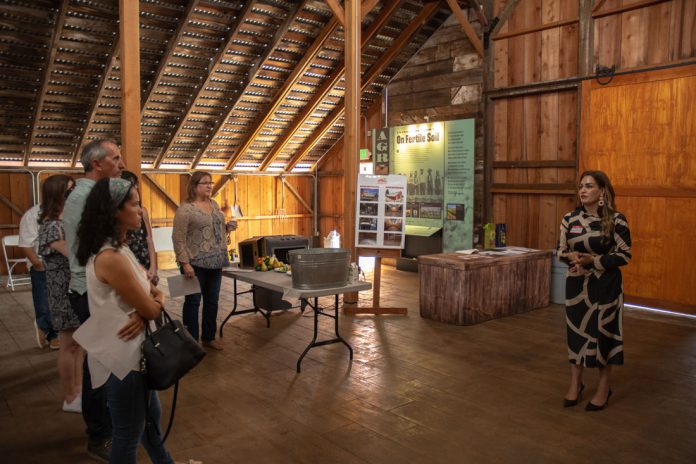
Local and county officials met with agricultural leaders at the restored Miller Red Barn to discuss policy changes aimed at supporting South County farmers, emphasizing a desire to collaborate closely to craft rules that update the county’s aging ordinances while reflecting the modern reality of its agricultural industry.
Santa Clara County Supervisor Sylvia Arenas joined Gilroy Mayor Greg Bozzo and City Councilmember Tom Cline on Sept. 16 at the historic barn near Christmas Hill Park to hear questions and concerns from farmers about regulatory barriers that some say threaten the survival of small farming operations in the South County.
The meeting included representatives from Visit Gilroy, the California Welcome Center, the South County Farm Association, the Santa Clara County Farm Bureau, Wineries of Santa Clara County, the Gilroy Beekeepers’ Association and the Gilroy Historical Society.
“We have an agricultural industry that brings in $370 million on an annual basis,” Arenas said. “We export 250 tons of garlic to Mexico alone. If you ask anybody on the other side of the country, or somewhere else, what Gilroy is known for, they will connect it to garlic.”
The gathering focused on proposed changes to the county’s rural zoning ordinance, which hasn’t been updated since the county’s general plan was last revised in 1995. Arenas compared operations with the outdated regulations to “having the same hairstyle since 1995,” illustrating the need for policies to evolve with changing agricultural practices.
“We evolve, because naturally, that is what we do as people, and our general plan should evolve with the needs of our community,” Arenas said. “Agriculture, as you can see, has changed over time, and what we used to do before—canning—is not necessarily the way that we want to eat our fruit any more.”
Stephanie Rocha of the South County Farms Association highlighted key issues facing small farmers, including restrictions on agritourism outside of wineries, and burdensome processes for building agricultural structures. She described a disconnect between county policies that officially support agriculture and the reality small farmers face when grappling with official processes.
“[Farmers are] running into a lot of major obstacles that are essentially either preventing these farms from continuing their operations or making it so that they, myself for example, are having to entertain possibly shutting down altogether,” she said.
Rocha outlined specific changes needed in the rural zoning amendments, including allowing agritourism on small farms similar to current winery operations and streamlining approval processes for agricultural buildings like livestock structures, processing facilities and cooling spaces.
“Right now it is very cumbersome and costly,” she said. “The math is not mathing for small farmers who want to wash their produce and package it and cool it. If they want to do that, they have to pay a ridiculous amount of money and go through a ridiculous process that we’re just not equipped to do.”
Rocha used a pointed metaphor to describe community resistance to changes that would support small agricultural operations.
“We get it, people want to keep South County ‘rural in character,’ but that’s like saying ‘I love apples but I hate apple trees,’” she said. “You gotta support and grow and nurture the apple tree. The small farmers out there are the apple tree, and we are struggling. We need real help, and not this very unfriendly environment.”
Cooperation key
The Miller Red Barn served as a symbolic venue for the agricultural discussion. Gary Walton, president of the Miller Red Barn Association, said the restored 1890s structure represents successful collaboration between county and local governments after more than a decade of restoration work by the nonprofit organization formed to prevent the barn’s demolition.
The barn was nearly demolished in 2014 before a community coalition secured funding for its restoration, including a $300,000 grant from Santa Clara County’s Historical Heritage Commission. Walton said the county’s financial support was crucial to completing the project.
“We would still be fundraising if the county hadn’t stepped up,” he said.
With restoration now largely complete, Walton described plans to “transform this historic barn into a vibrant community hub, one that nurtures local agriculture and farmers, fosters agricultural learning, expands agritourism and celebrates the unique heritage of our region.”
Bozzo expressed strong support for regional agricultural development efforts, saying he “completely supports any conversation that is around economic development in South County, agriculture in South County, and ag heritage in the name of education in South County.”
Walton emphasized the collaborative approach needed for success, calling for broader participation from the agricultural community, and encouraged interested farmers, organizations and community leaders to get involved.
“As we move forward, we know that this is bigger than any one group,” he said. “The more voices and partners at the table, the stronger our impact can be.”












